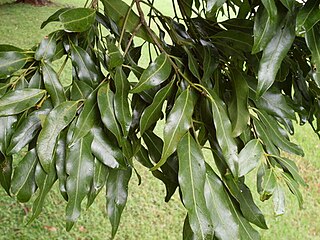
Cinnamomum oliveri is a rainforest tree growing at the eastern coastal parts of Australia. It grows from the Illawarra district in New South Wales to Cape York Peninsula at the northern tip of Australia. The southernmost limit of natural distribution is on the volcanic cliffs above the town of Gerroa and nearby on the sand in rainforest behind Seven Mile Beach, New South Wales.
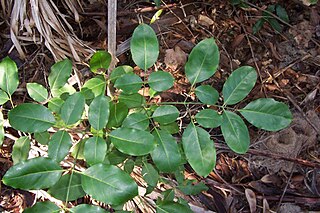
Polyscias elegans, known as the celery wood, is a rainforest tree of eastern Australia. It occurs in a variety of different rainforest types, from fertile basaltic soils, to sand dunes and less fertile sedimentary soils. The range of natural distribution is from Jervis Bay in southern New South Wales to Thursday Island, north of the Australian continent. Other common names include black pencil cedar and silver basswood. Polyscias elegans is useful to bush regenerators as a nursery tree, which provides shade for longer-lived young trees underneath. Polyscias elegans is also known as Celery wood, Mowbulan whitewood, Silver basswood and White sycamore.

Endiandra discolor is an Australian tree, growing from near Gosford, New South Wales to Tully, Queensland in the tropics. Common names include rose walnut and domatia tree.
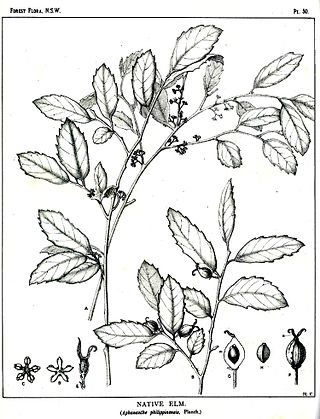
Aphananthe philippinensis is a common rainforest tree in the family Cannabaceae. In Australia it occurs from the Manning River in New South Wales to near Herberton in tropical Queensland. It was first described from the island of Luzon in the Philippines, hence the species name. The generic name of Aphananthe refers to insignificant flowers. This plant also occurs on the Solomon Islands and in Papua New Guinea

Endiandra virens is an Australian tree in the laurel family. Growing from Boorganna Nature Reserve north west of Taree, New South Wales to Kin Kin in Southern Queensland. Common names include White Apple, Plumwood, and New South Wales Walnut.

Daphnandra johnsonii, also known as the Illawarra socketwood, is a rare rainforest tree in the Illawarra district of eastern Australia.

Elattostachys nervosa, known as the green tamarind or beetroot tree is a common rainforest tree of eastern Australia. Found in all types of rainforest, growing from Paterson, New South Wales in the south to Gympie in south east Queensland. The name Elattostachys refers to "little spikes", a flower feature of other plants in this genus. Nervosa refers to the prominent leaf venation. Beetroot Tree refers to the beetroot red leaves of the new growth.

Ficus virens var. sublanceolata is a banyan or strangler fig. It grows alongside the related white fig in the northern part of its range. They differ with narrower leaves, almost lanceolate in shape. Common names in Australia include white fig, sour fig, deciduous fig and banyan. A large example can be seen north of Murwillumbah beside the old Pacific Highway, not far from the state border with Queensland.

Mallotus philippensis is a plant in the spurge family. It is known as the kamala tree or red kamala or kumkum tree, due to the fruit covering, which produces a red dye. However, it must be distinguished from kamala meaning "lotus" in many Indian languages, an unrelated plant, flower, and sometimes metonymic spiritual or artistic concept. Mallotus philippensis has many other local names. This kamala often appears in rainforest margins. Or in disturbed areas free from fire, in moderate to high rainfall areas.

Niemeyera whitei known as the rusty plum or plum boxwood is a rare tree of eastern Australia. It occurs on poorer soils in areas below 600 metres above sea level. Found in gully, warm temperate or littoral rainforests. From the Macleay River, New South Wales to Tallebudgera Creek in south eastern Queensland.
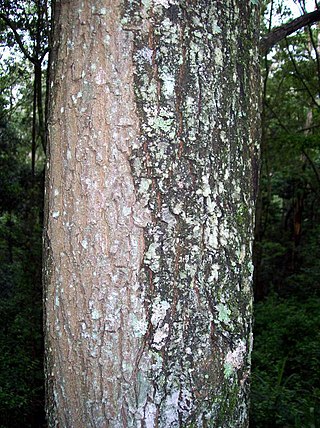
Bridelia exaltata, known as the brush ironbark or scrub ironbark, is a tree of eastern Australia. It occurs in and on the margins of the drier rainforests. Also occurring by streams, often in association with the Black Bean, up to an elevation of 600 metres above sea level. It occurs from Seal Rocks, New South Wales to Maryborough, Queensland.
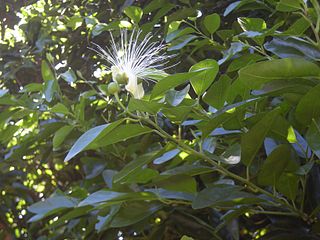
Capparis arborea is a bush or small tree occurring in eastern Australia. The habitat is rainforest; usually riverine, littoral or the drier rainforests. Distributed from the Hunter River, New South Wales to Cape Melville in tropical Queensland. Common names include native pomegranate, wild lime, wild lemon and brush caper berry.

Rhodamnia argentea is a rainforest tree of eastern Australia. Commonly known asmalletwood, white myrtle, silver leaf, silver malletwood and white turpentine. The natural habitat is a variety of different rain forests, at sea level or in the adjacent ranges. Growing on sand, alluvium and volcanic based soils. From the Hastings River, New South Wales to Bowen, Queensland.

Endiandra introrsa is a rare rainforest tree growing in eastern Australia. Listed with a Rare or Threatened Australian Plants (ROTAP) rating of 3RCa. Its habitat is warm temperate rainforest on the poorer rainforest soils, mostly over 300 metres in altitude, and its range of natural distribution is from near Dorrigo to various sites in the state of Queensland.

Petalostigma triloculare, known as the long-leaved bitter bark is a rainforest tree of eastern Australia. It occurs in the drier rainforests, often on sandy soil derived from granite or sandstone, and is sometimes seen on old sand dunes.

Planchonella queenslandica, the blush condoo, is a large rainforest tree of the family Sapotaceae native to eastern Australia. It is found in sea side rainforest as well as the drier inland rainforests. From as far south as the Richmond River, New South Wales to Coen in tropical Queensland, and as far west as Melville Island, Northern Territory.

Triflorensia cameronii is a very rare rainforest plant of the coffee family, growing in a few areas of eastern Australia. Found in Lismore, New South Wales as well as a few other locations in nearby Queensland. Soils are based on basalt, and the rainforest is the drier type, with hoop pine nearby.
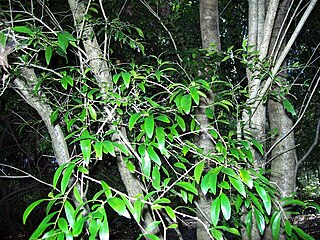
Pittosporum lancifolium, known as the narrow-leaved orange thorn or sticky orange thorn, is a shrub or tree growing in eastern Australia. Often found at altitudes above 500 metres above sea level; from Mallanganee National Park in New South Wales in the south to Yarraman in south east Queensland in the north.

Elattostachys xylocarpa, known as the white tamarind or short-leaf beetroot is a common rainforest tree of eastern Australia. Found in the drier rainforests, which are based on volcanic soils. From as far south as the Orara River in northern New South Wales to Bowen in tropical Queensland. The name Elattostachys refers to "little spikes", a flower feature of other plants in this genus. xylocarpa refers to the hard woody fruit.

Neolitsea australiensis, also known as the green bolly gum, is an Australian rainforest tree, in the laurel family. The specific epithet is derived from "Australia", and the Latin "ensis"; meaning "native of Australia".




















